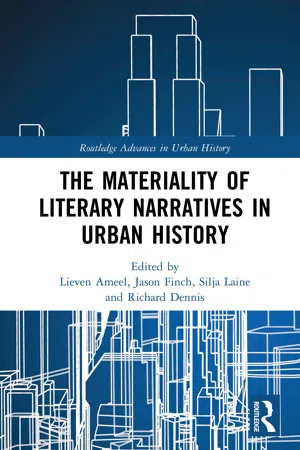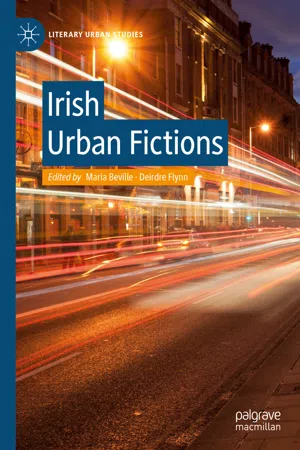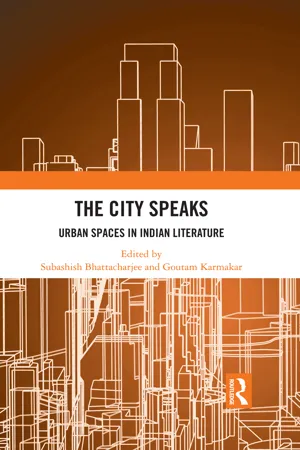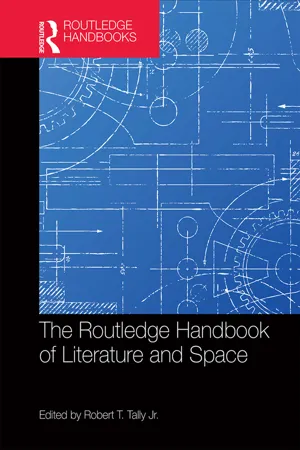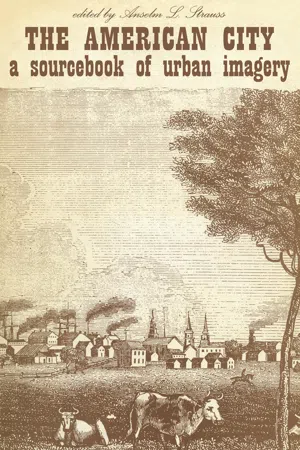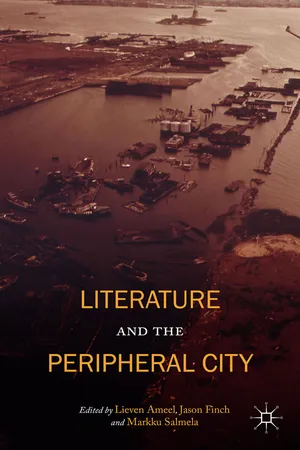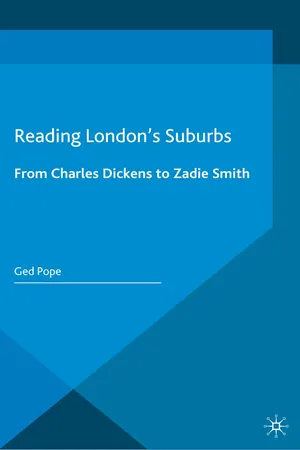Literature
Urban Fiction
Urban fiction is a literary genre that focuses on the lives and experiences of characters in urban settings, often depicting the struggles and realities of inner-city life. It typically explores themes such as crime, poverty, and street culture, and is known for its raw and gritty portrayal of urban environments. This genre has gained popularity for its authentic representation of urban life.
Written by Perlego with AI-assistance
Related key terms
7 Key excerpts on "Urban Fiction"
- Lieven Ameel, Jason Finch, Silja Laine, Richard Dennis(Authors)
- 2019(Publication Date)
- Routledge(Publisher)
The first section of the book, ‘Literary Fiction as Urban Materiality’, examines literary writing in genres such as the novel and the lyric poem as a complex and highly aestheticised investigation of urban material structures. It focusses in particular on how literary texts provide insights into embodied experiences of historical cities. At the same time, literary fiction is introduced here as being part and parcel of urban materiality: literary texts and literary production are constitutive of specific kinds of urban experience and their renderings in narrative form. Among other things, literary texts are also part of the city. They are manufactured productions of the city as surely as are railings, clocks, and buses.In addition to being of the city, literary narratives investigate and comment upon the environment in which they were formed. The book’s second section, ‘Literary Narratives as Social Investigations of the Material City’, approaches literary narratives as providers of tactile knowledge concerning the history of urban poverty and urban social problems, and concerning marginalised groups in the city. Narrative forms and genres such as poetry, children’s comics, and literary journalism will be foregrounded in this section as useful sources for urban history – text types that in literary urban studies, with its focus on the prose novel, have remained somewhat underdeveloped. Narratives are seen here as investigating, discursively constructing, and actively shaping responses to urban social problems.The book’s third section is entitled ‘Narrating Silenced Material Lives’. This section examines literary narratives as important sources for documenting the qualitative aspects of material lives that without them would have disappeared and as tools for reconstituting earlier silenced spatial and material histories. New insights into forgotten, neglected, or otherwise inaccessible voices in urban history are in this section brought centre stage through the examination of literary narratives.Literary Fiction as Urban Materiality
In the first chapter in this section, ‘Between the Street and the Drawing Room: Slumming in Eliot’s Early Poetry’, Bo Pettersson examines T.S. Eliot’s early poetry in view of Eliot’s predilection for slumming. Pettersson argues that Eliot’s detailed observations of upper-class life must be set against his equally searching scrutiny of prostitution, squalor, and decay in rather explicit language. The article shows that nightly strolls and related reading, especially Charles-Louis Philippe’s slum depictions Bubu de Montparnasse and Marie Donadieu , helped to open the young Eliot’s eyes to another side of urban life that informed much of his early poetry and set him on the path to The Waste Land- eBook - ePub
- Maria Beville, Deirdre Flynn, Maria Beville, Deirdre Flynn(Authors)
- 2018(Publication Date)
- Palgrave Macmillan(Publisher)
Writers and characters in these fictions engage with Irish places, fictional and real, and the cultural implications of the specifics of representation are important. The chapters in this volume examine how Irish urbanites see themselves within their own urban spaces and how narratives of identity are conjoined with narratives of place. In doing so they ask how does the rural Irish literary tradition impact on their experience of the city? How do urban Irish locations differ from recurring images of the city in literature? And does the unique cultural and historical past and present of the island of Ireland create contrasting urban experiences north and south of the border? These are questions specific to Irish Urban Fictions. They challenge us to think about important issues relevant to the literary urban landscape. McNamara suggests that literary forms have been the ‘building blocks of […] collective identity for millennia’. 29 If so, then what does the collective cultural identity of the urban suggest about Ireland? And how has urban literature contributed to the development of this collective identity? A Multilateral Perspective The chapters in this book approach the city and the urban spaces that unfold within and around it, by drawing the concept of ‘Irish fiction’ away from notions of the rural and the regional. The collection’s vision expands the idea of the city in Irish writing to reveal a host of utopian, dystopian, and heterotopic textual spaces that frequently converge with the consciousness of the city dweller. In doing so, it forms a perspective which opens up the urban in Irish fiction as an important site for social commentary on contemporary Irish culture and society. Each of the three sections builds on these notions, and the chapters therein combine to form a critical introduction to Irish Urban Fictions - eBook - ePub
The City Speaks
Urban Spaces in Indian Literature
- Subashish Bhattacharjee, Goutam Karmakar, Subashish Bhattacharjee, Goutam Karmakar(Authors)
- 2022(Publication Date)
- Routledge India(Publisher)
Recent humanities scholarship has shown an inclination towards studying the city culturally, socially, and politically, projecting and presenting ever-new paradigms of study and scholarly recreation by engaging the spaces of, within, and without the cities. The cities in books by David Harvey, Douglas Murphy, Ravi Sundaram, Vinay Lal, Ash Amin, and Nigel Thrift, among others, show cities as actants in a world that has to evolve through technology and constant and increasingly complicated human interaction. In recent years, there has been a rise in the cultural interactions between the city and literature, marking zones of national, cultural, and linguistic interest specific to geographical conditioning and a greater cohesion of the idea of the cities through narratives, and this has led to the production of at least a few books that try to decode the literary in the urban and the urban in literature, to put it rather simplistically.The city has been a zone of contention for a considerable amount of time in literature – a producer of narratives as well as a consumer. These cities have embodied their characters and their narratives in a way that is reflective of the city’s topology, genealogy, and living archaeology. Literature, therefore, often serves to excavate the cities through its representations, and is also, in turn, unearthed. Rather than seeing the city as a null-space that exists horizontally to frame the literary work, cities in literary works from its diverse cultural and national histories have become more serpentine, transgressive, and unpredictable. These cities can be utopias or dystopias, safe havens or places of terminal oppression, but they are functional mechanisms that are more often than not an intricate aspect of the text/performance itself. Within this vast historio-’city’, the urban space in Indian literature has reached a tipping point, a point of intervention that necessitates that these adaptations be evaluated subjectively, informed by the nuances of critical theorisation, rather than as a mere set of pieces. But not merely in the area/s of literary creation, the burgeoning sphere of media studies surrounding urban spaces/spatialities in India has led to the mushrooming of such developments as the Sarai programme (CSDS and the Raqs Media Collective), and its consequent research output that is accessible through their site, and Vinay Lal’s two-volume The Oxford Anthology of the Modern Indian City besides a whole host of other works that discern the Indian city (or analogical ‘others’ to Indian cities) as the host-space, the ground zero for a fomentation of change, a site of evolution, and dissemination of radical thought. And this radical thought pervades the literary works that feed on cities. While such a commentary poses the risk of being elitist and exclusive in nature – by keeping the rural space outside its deliberation – historically, India has a stronger literary tradition of rural spaces than a similar correspondence with urban spaces. Independence, followed by the Emergency, and thereafter the liberalisation of the economy, finally pushed the attention of writers towards the urban centres as more than mere props. Therefore, even if we are to casually remark on the status of Narayan’s Malgudi as contentious towards an urban-representative literary state, it is indeed a more deliberate attempt to ingratiate the city within the story until it is no longer so – Narayan fleshes out Malgudi progressively while it corresponds to a native tradition of rural-urban narrative, and acts more in line with a rural-revivalist narrative. But the more recent developments have been more decisive in this regard. An Anita Desai novel that chronicles the city – In Custody - eBook - ePub
- Robert Tally Jr., Robert T. Tally Jr.(Authors)
- 2017(Publication Date)
- Routledge(Publisher)
1 While a vast amount of research has been conducted on the images and experiences of the city in the literary works of individual authors, and on the literatures of particular cities and literary periods, less progress has been made to articulate what distinguishes city novels from other literary texts. What kinds of generic characteristics are typical for city literature, and what are the consequences of these features for an analysis of the city novel? Given the close correlation between city literature and the interdisciplinary field of urban studies, such an enquiry could also have relevance beyond literary studies, with the potential to broaden our understanding of how city narratives are constructed in the context of education, history, urban planning and policy.In this chapter, I will argue that the city novel is characterized by a measuring of distances : distances in space, of course, but also distances between literary and actual locations; distances protagonists or communities cover, and distances felt by the protagonist(s) when confronted by the depth of personal memories and shared histories. My arguments will be substantiated by an analysis of selected New York novels.Towards a definition of the city novel genre
Literary urban studies is not lacking in typologies. Several scholars have developed useful two-, three- or fourfold taxonomies with which to examine different kinds of city novels. Peter Keating, in “The Metropolis in Literature”, for example, divides literary city representations into two traditions, defined by either a comprehensive or an internalized view.2 Blanche Gelfant provides a tripartite distinction between the portrait novel, the ecological novel and the synoptic novel.3 Drawing on Bakhtin’s theory of chronotopes, Bart Keunen distinguishes four chronotopes in the modernist city novel: the idyllic, documentary, self-referential and hyperrealist chronotopes.4 - eBook - ePub
The American City
A Sourcebook of Urban Imagery
- David Riesman(Author)
- 2017(Publication Date)
- Routledge(Publisher)
In the writings of novelists like Steinbeck, and especially in their works of fiction, the American city rarely appears as mere backdrop, as static stage setting, against which are enacted the sufferings and dreams of men. The city itself is perceived as animate and potent. It makes and breaks men: sometimes promising opportunities and providing for their fulfillment; but sometimes luring or trapping them, and exacting payment. American urban novels, whose characters move in and about a city landscape, provide a composite image of “the city” as conceived over the decades by an enormous number of Americans. This mass of urban folklore can help us construct a mosaic composed of some meanings that cities have had for Americans.Taken as a group, novelists have portrayed life in the city not only more dramatically—more humanly, if you wish—than their scholarly contemporaries, the sociologists, the geographers, the planners; but they have been less heir perhaps to inherited intellectual views which divert gaze and cramp vision. One may instance here what is perhaps the outstanding single article by a sociologist on the nature of urban life, a paper by Louis Wirth 2 who, in the thirties, systematically set down what amounts to a range of urban perspectives measurably narrower than those expressed by the novels in any moderately sizable public library.Having seen what the novelists have to say about social relations in the city, how their people imagine the city to be and how they cope with and use the city, we shall be in a better position to ask how Americans have come to see their cities in these several ways—and what difference it makes whether cities are conceived from one viewpoint or another.Urban Heterogeneity
One classic theme of the urban novel pertains to the diversity of every large city’s worlds and populations. Drawn from the four quarters of the earth—or at least from neighboring states—the city teems with the people of different races, origins, cultures, and beliefs; not merely peoples of two or even three contrasting classes. This motif is reflected in the local press (boasts of the melting pot and living together, along with reports of ethnic and racial tensions); and in journalistic accounts which attempt to capture the color and spirit of particular cities, whose unique qualities are partly attributed to the characteristics of its diverse populations. Photographers of city life love to show its contrasts: the range of ethnic faces in the crowd, the multiplicity of kinds of city life, as well as the poignancy of Park Avenue and office buildings towering over slum dwellings. - eBook - ePub
- Jason Finch, Markku Salmela, L. Ameel(Authors)
- 2015(Publication Date)
- Palgrave Macmillan(Publisher)
But work produced in such a framework risks losing perspective. This can manifest itself in a failure to understand one enormous city in relation to others of different sizes and a tendency to treat the one city as if it were a world in itself, self-sufficient and self-serving. The idea of a city as imago mundi, the image of the whole world, may be a commonplace in city literature, but it could best be treated with suspicion by scholars of the literary city. Most, if not all of the above studies of the literary city have pointed out the crucial relevance of genre and period conventions in shaping urban experiences in literature. Several monographs have been devoted to examining the link between city experiences in literature and the period and genre conventions in which they are steeped. Examples include Nicholas Freeman’s Conceiving the City, on turn-of-the-twentieth-century London, Lawrence Phillips’s collection on Victorian and Edwardian London and Christophe Den Tandt’s The Urban Sublime in American Literary Naturalism. But scholarship often assumes that genre and period conventions are most clearly visible in central cities and a few privileged national literatures, and can then be “exported” wholesale to more marginal and peripheral cities. Work on modernist studies as it appears in a journal like Modernism/Modernity, for example, certainly explores the manifestations of modernism in cities from Tokyo to Tbilisi (Chikhradze; Weisenfeld), but rarely questions the secondary or subaltern status of these cities in relation to the supposed global capitals of modernism, Paris and New York. The same is true for literary tradition, in which Zola’s naturalist Paris is made prior to and foundational for parallel accounts of northern European cities, or, say, Latin American cities. A fuller examination of the relationship between literature and urban peripherality will reveal the limitations of such an approach - eBook - ePub
Reading London's Suburbs
From Charles Dickens to Zadie Smith
- G. Pope(Author)
- 2015(Publication Date)
- Palgrave Macmillan(Publisher)
semiotic challenge: subUrban Fiction is of vital importance because it foregrounds the very ways in which individuals make sense of and inhabit the world. SubUrban Fiction foregrounds the broader processes (and related difficulties) by which individuals can be said to construct and inhabit a rich and meaningful habitat.Suburban-set fiction, then, dramatises and enacts the struggle that all individuals face in creating a convincing life-world. In this sense reading London suburban-set fiction of the last 150 years we can see that such work foregrounds a particular crisis of cultural and social modernity. Suburban narratives dramatise the semiotic difficulties faced by individuals struggling to read and interpret the modern sites of mass, private domesticity, to form a knowable community, to be at home there.A useful way to discuss subUrban Fiction in this light is to use some approaches from the fast expanding field of ‘global semiotics’. For thinkers such as Thomas Sebeok, Jesper Hoffmeyer and others, and building on original work in semiotics by C. S. Peirce (not, I must emphasise, the semiology of Saussure, which is concerned with human verbal signs alone), semiotics is the study of sign production and interpretation in all creatures inhabiting specific environments.What I usefully take from Piercean semiotics is the key insight that there is a reality which we (and all living things) can, and must, grasp – however partially – if we are to survive (and evolve). Crucially, this reality is the semiotically mediated reality of our species: the personal ‘lifeworld’ that the individual creates in everyday semiotic interaction with the world. Broadly speaking, this is what semiologists call the ‘umwelt’; the constitutive ‘reality’ of a particular environment for that individual being. ‘Umwelten’, as Wendy Wheeler points out, ‘are signifying environments composed of signs which are meaningful in the survival of any species’ (Wheeler, 140). Semiotics can provide a helpful theoretical model for discussing subUrban Fiction, then, because it can offer a useful account of how ‘real’ physical material environments are read and moulded by the creative cognitive faculties, and other capacities, of the perceiving subject.
Index pages curate the most relevant extracts from our library of academic textbooks. They’ve been created using an in-house natural language model (NLM), each adding context and meaning to key research topics.
